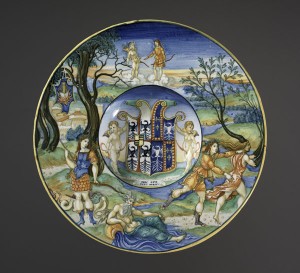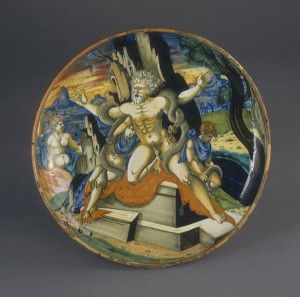
Nicola da Urbino
Maiolica plate with The Legend of Apollo and Daphne and the joined arms of Isabella d’Este and Francesco Gonzaga, c. 1524–5
Tin-glazed earthenware, diameter 27.1 cm; h. 4.5 cm (10 7/10 in.; 1 4/5 in.)
British Museum, London
© Trustees of the British Museum
Dining ranked as one of the most important social activities of the Renaissance, an ideal occasion for announcing one’s status. Abundant evidence conveys that specially crafted pieces of tableware functioned as a way of proclaiming wealth, taste, and erudition. Some wares were made for the family itself, others were intended as gifts for weddings, births, and other important occasions. The seventeenth-century Italian priest and gourmand Giovanni Battista Barpo, writing on the delights of personal gastronomy, noted the importance of fine tableware:
at your villa you should have—according to your means—several spoons and forks of silver and some plates of beautiful maiolica in order always to retain a measure of civility and to show that you are well born.9
Isabella d’Este exemplifies the connoisseur patron who commissioned elegantly designed plates with illustrations of classical stories, indications of her familiarity with antique texts and her love of learning. A fine example is this ceramic plate with classical allusions, made c. 1524–5 of maiolica—tin-glazed earthenware. It contains scenes of virtue that allude to the chastity of Isabella and the valor of her husband, Francesco Gonzaga (then deceased). In the center of the plate, two winged putti present the joined arms of Isabella and her husband above a banner that shows one of Isabella’s favorite personal mottoes: NEC SPE / NEC METU (neither hope nor fear). On the outer rim of the plate, concisely rendered vignettes provide a panorama of classical themes with pointed moral content.

Attributed to Francesco Xanto Avelli
Bowl with Laocoön, 1539
Tin-glazed earthenware, diameter 27 cm (10 5/8 in.)
National Gallery of Art, Washington, DC, Widener Collection
Image courtesy of the Board of Trustees, National Gallery of Art
A connoisseur could demonstrate knowledge of antique material by commissioning maiolica plates that featured masterpieces of classical sculpture. A good example is this plate, dated 1539 on the reverse. Against a vivid landscape the plate depicts the Trojan priest Laocoön. The Hellenistic statue of Laocoön had been unearthed to much acclaim in Rome in 1506 and later entered the distinguished and well-publicized papal collection of antiquities. Laocoön had attempted in vain to warn his people against Greek stratagems and was subsequently punished by the goddess Minerva, who sent monstrous snakes to attack both him and his two sons. The Laocoön was widely recognized as one of the most important sculptures of the ancient world. Displaying a painted image of the figure at the dinner table allowed the owner of the plate to demonstrate a knowledge and appreciation of this famous work.
In the late fifteenth century, the glass furnaces of Venice began to produce glass vessels and plates, often in elaborate designs, which were also sought after by connoisseur patrons. A patron of extremely refined taste saw to it that his table was decorated with an object representing the most technologically advanced and aesthetically ambitious tableware of the day. He might, for example, commission pieces from Hermonia Vivarini, who had been granted a special patent to produce vessels in the form of ship.